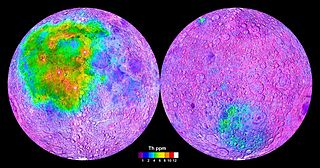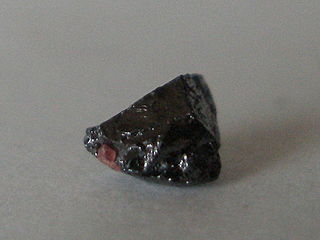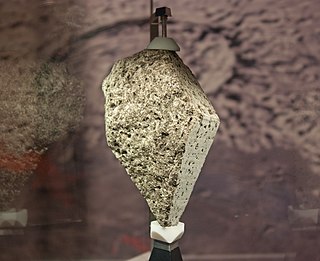Related Research Articles

KREEP, an acronym built from the letters K, REE and P, is a geochemical component of some lunar impact breccia and basaltic rocks. Its most significant feature is somewhat enhanced concentration of a majority of so-called "incompatible" elements and the heat-producing elements, namely radioactive uranium, thorium, and potassium.

Anorthosite is a phaneritic, intrusive igneous rock characterized by its composition: mostly plagioclase feldspar (90–100%), with a minimal mafic component (0–10%). Pyroxene, ilmenite, magnetite, and olivine are the mafic minerals most commonly present.

Armalcolite is a titanium-rich mineral with the chemical formula (Mg,Fe2+)Ti2O5. It was first found at Tranquility Base on the Moon in 1969 during the Apollo 11 mission, and is named for Armstrong, Aldrin and Collins, the three Apollo 11 astronauts. Together with tranquillityite and pyroxferroite, it is one of three new minerals that were discovered on the Moon. Armalcolite was later identified at various locations on Earth and has been synthesized in the laboratory. (Tranquillityite and pyroxferroite were also later found at various locations on Earth). The synthesis requires low pressures, high temperatures and rapid quenching from about 1,000 °C to the ambient temperature. Armalcolite breaks down to a mixture of magnesium-rich ilmenite and rutile at temperatures below 1,000 °C, but the conversion slows down with cooling. Because of this quenching requirement, armalcolite is relatively rare and is usually found in association with ilmenite and rutile, among other minerals.

A micrometeorite is a micrometeoroid that has survived entry through the Earth's atmosphere. Usually found on Earth's surface, micrometeorites differ from meteorites in that they are smaller in size, more abundant, and different in composition. The IAU officially defines meteorites as 30 micrometers to 1 meter; micrometeorites are the small end of the range (~submillimeter). They are a subset of cosmic dust, which also includes the smaller interplanetary dust particles (IDPs).

Schreibersite is generally a rare iron nickel phosphide mineral, (Fe,Ni)3P, though common in iron-nickel meteorites. It has been found on Disko Island in Greenland and Illinois.

Moon rock or lunar rock is rock originating from Earth's Moon. This includes lunar material collected during the course of human exploration of the Moon, and rock that has been ejected naturally from the Moon's surface and landed on Earth as meteorites.

Troilite is a rare iron sulfide mineral with the simple formula of FeS. It is the iron-rich endmember of the pyrrhotite group. Pyrrhotite has the formula Fe(1-x)S which is iron deficient. As troilite lacks the iron deficiency which gives pyrrhotite its characteristic magnetism, troilite is non-magnetic.

Pyroxferroite (Fe2+,Ca)SiO3 is a single chain inosilicate. It is mostly composed of iron, silicon and oxygen, with smaller fractions of calcium and several other metals. Together with armalcolite and tranquillityite, it is one of the three minerals which were discovered on the Moon. It was then found in Lunar and Martian meteorites as well as a mineral in the Earth's crust. Pyroxferroite can also be produced by annealing synthetic clinopyroxene at high pressures and temperatures. The mineral is metastable and gradually decomposes at ambient conditions, but this process can take billions of years.
Stuart Olof Agrell was an optical mineralogist and collaborator applying the electron microprobe to petrology. His involvement in the Apollo program brought him to the attention of the British media and public. He was also interested in moon rocks and the moon itself.

Leon Theodore Silver was an American geologist who was professor of geology at the California Institute of Technology (Caltech). He was an instructor to the Apollo 13, 15, 16, and 17 astronaut crews. Working with the National Aeronautics and Space Administration (NASA), he taught astronauts how to perform field geology, essentially creating lunar field geology as a new discipline. His training is credited with a significant improvement in the J-Mission Apollo flights' scientific returns. After the Apollo program, he became a member of the United States National Academy of Sciences in 1974. He retired as the W. M. Keck Foundation Professor for Resource Geology, emeritus, at Caltech.

Seifertite is a silicate mineral with the formula SiO2 and is one of the densest polymorphs of silica. It has only been found in Martian and lunar meteorites, where it is presumably formed from either tridymite or cristobalite – other polymorphs of quartz – as a result of heating during the atmospheric re-entry and impact to the Earth, at an estimated minimal pressure of 35 GPa. It can also be produced in the laboratory by compressing cristobalite in a diamond anvil cell to pressures above 40 GPa. The mineral is named after Friedrich Seifert (born 1941), the founder of the Bayerisches Geoinstitut at University of Bayreuth, Germany, and is officially recognized by the International Mineralogical Association.

The composition of Mars covers the branch of the geology of Mars that describes the make-up of the planet Mars.
George Tilton was an American geochemist who specialized in uranium-lead geochronology. He was the first to measure a U-Pb date on zircon and was instrumental in developing analytical techniques for the measurement of U, Th, and Pb in minerals and rocks, using isotope dilution and mass spectrometry.
Robert Norman Clayton was a Canadian-American chemist and academic. He was the Enrico Fermi Distinguished Service Professor Emeritus of Chemistry at the University of Chicago. Clayton studied cosmochemistry and held a joint appointment in the university's geophysical sciences department. He was a member of the National Academy of Sciences and was named a fellow of several academic societies, including the Royal Society.

Hadean zircon is the oldest-surviving crustal material from the Earth's earliest geological time period, the Hadean eon, about 4 billion years ago. Zircon is a mineral that is commonly used for radiometric dating because it is highly resistant to chemical changes and appears in the form of small crystals or grains in most igneous and metamorphic host rocks.
John Francis Lovering was an Australian geologist. He was Professor of Geology at the University of Melbourne from 1969 to 1987 and Vice-Chancellor of Flinders University from 1987 to 1995.
CM chondrites are a group of chondritic meteorites which resemble their type specimen, the Mighei meteorite. The CM is the most commonly recovered group of the 'carbonaceous chondrite' class of meteorites, though all are rarer in collections than ordinary chondrites.

Katherine Helen Joy is a Reader in Earth Sciences at the University of Manchester. Joy has studied lunar samples from the Apollo program as part of her research on meteorites and lunar science.
Gas-rich meteorites are meteorites with high levels of primordial gases, such as helium, neon, argon, krypton, xenon and sometimes other elements. Though these gases are present "in virtually all meteorites," the Fayetteville meteorite has ~2,000,000 x10−8 ccSTP/g helium, or ~2% helium by volume equivalent. In comparison, background level is a few ppm.
Ghislaine Crozaz is a cosmochemist known for her research on the early history of the solar system through tracking trace elements in meteorites.
References
- Citations
- 1 2 3 4 Nickel, Ernest H.; Nichols, Monte C., eds. (2009). "The official IMA-CNMNC List of Mineral Names" (PDF). Commission on New Minerals, Nomenclature And Classification. International Mineralogical Association . Retrieved 7 January 2012.
- ↑ Warr, L.N. (2021). "IMA–CNMNC approved mineral symbols". Mineralogical Magazine. 85 (3): 291–320. Bibcode:2021MinM...85..291W. doi: 10.1180/mgm.2021.43 . S2CID 235729616.
- 1 2 Lovering et al. 1971, p. 40
- ↑ Lovering et al. 1971, p. 41
- ↑ Lovering et al. 1971
- 1 2 "Tranquillityite". Mindat.org. Retrieved 2010-08-07.
- ↑ "Tranquillityite". Webmineral. Retrieved 2010-08-07.
- 1 2 3 Fleischer 1973
- ↑ Handbook of Mineralogy
- 1 2 "Rare Moon mineral found in Australia". ABC News . 5 January 2012. Retrieved 15 January 2021.
- ↑ Ramdohr & El Goresy 1970
- ↑ Cameron 1970
- ↑ Dence et al. 1970 , p. 324
- ↑ Meyer, Charles (2009). "Sample 10047:Ilmenite Basalt (low K) 138 grams Figure" (PDF). NASA Lunar Sample Compendium. Nasa. Retrieved 7 January 2012.
- ↑ Heiken, Vaniman & French 1991 , pp. 133–134
- ↑ Walker, Fleischer & Buford Price 1975 , p. 505
- 1 2 3 4 Gatehouse et al. 1977
- ↑ Hinthorne et al. (1979)
- ↑ Rasmussen, Fletcher & Muhling (2008)
- ↑ Hinthorne et al. 1979 , pp. 271–303
- 1 2 Rasmussen, Fletcher & Muhling 2008
- ↑ Lunar Sample Mineralogy, NASA
- ↑ Russell et al. 2002
- ↑ Leroux & Cordier 2006
- 1 2 Rassmussen et al. 2012
- ↑ Lovering et al. 1971 , pp. 42–43
- Bibliography
- Cameron, E. N. (1970). "Opaque minerals in certain lunar rocks from Apollo 11". Proceedings of the Apollo 11 Lunar Science Conference (5–8 January 1970, Houston, TX). Geochimica et Cosmochimica Acta Supplement. 1: Mineralogy and Petrology: 193–206. Bibcode:1970GeCAS...1..221C.
- Dence, M. R.; Douglas, J. A. V.; Plant, A. G.; Traill, R. J. (1970). "Petrology, Mineralogy and Deformation of Apollo 11 Samples". Proceedings of the Apollo 11 Lunar Science Conference (5–8 January 1970, Houston, TX). Geochimica et Cosmochimica Acta Supplement. 1: Mineralogy and Petrology: 315–340. Bibcode:1970GeCAS...1..315D.
- Fleischer, Michael (1973). "New mineral names" (PDF). American Mineralogist. 58 (1–2): 139–141.
- Gatehouse, B. M.; Grey, I. E.; Lovering, J. F.; Wark, D. A. (1977). "Structural studies on tranquillityite and related synthetic phases". Proceedings of the Lunar Science Conference, 8th, Houston, Tex., March 14–18, 1977. New York: Pergamon Press, Inc. 2 (A78-41551 18–91): 1831–1838. Bibcode:1977LPSC....8.1831G.
- Heiken, Grant; Vaniman, David; French, Bevan M. (1991). Lunar Sourcebook : a User's Guide to the Moon. Cambridge: Cambridge Univ. Press. pp. 133–134. ISBN 978-0-521-33444-0 . Retrieved 7 January 2012.
- Hinthorne, J.R.; Andersen, C.A.; Conrad, R.L; Lovering, J.F. (1979). "Single-grain 207Pb/206Pb and U/Th age determinations with a 10-micron spatial resolution using the ion microprobe mass analyzer (IMMA)". Chem. Geol. 25 (4): 271–303. Bibcode:1979ChGeo..25..271H. doi:10.1016/0009-2541(79)90061-5.
- Leroux, Hugues; Cordier, Patrick (2006). "Magmatic cristobalite and quartz in the NWA 856 Martian meteorite". Meteoritics & Planetary Science. 41 (6): 913923. Bibcode:2006M&PS...41..913L. doi: 10.1111/j.1945-5100.2006.tb00495.x .
- Lovering, J. F.; Wark, D. A.; Reid, A. F.; Ware, N. G.; Keil, K.; Prinz, M.; Bunch, T.E.; El Goresy, A.; Ramdohr, P.; et al. (1971). "Tranquillityite: A new silicate mineral from Apollo 11 and Apollo 12 basaltic rocks". Proceedings of the Lunar Science Conference. 2: 39–45. Bibcode:1971LPSC....2...39L.
- Ramdohr, Paul; El Goresy, Ahmed (30 January 1970). "Opaque Minerals of the Lunar Rocks and Dust from Mare Tranquillitatis". Science. Ahmed. 167 (3918): 615–618. Bibcode:1970Sci...167..615R. doi:10.1126/science.167.3918.615. PMID 17781517. S2CID 27627972.
- Rasmussen, Birger; Fletcher, Ian R.; Muhling, Janet R. (2008). "Pb/Pb Geochronology, Petrography and Chemistry of Zr-rich Accessory Minerals (Zirconolite, Tranquillityite and Baddeleyite) in Mare Basalt 10047". Geochimica et Cosmochimica Acta. 72 (23): 5799–5818. Bibcode:2008GeCoA..72.5799R. doi:10.1016/j.gca.2008.09.010.
- Rasmussen, Birger; Fletcher, Ian R.; Gregory, Courtney J.; Muhling, Janet R.; Suvorova, Alexandra A. (2012). "Tranquillityite: The last lunar mineral comes down to Earth". Geology. 40 (1): 83–86. Bibcode:2012Geo....40...83R. doi:10.1130/G32525.1.
- Russell, Sara S.; Zipfel, Jutta; Grossman, Jeffrey N.; Grady, Monica M. (2002). "The Meteoritical Bulletin N°86 2002 July". Meteoritics & Planetary Science. 37 (S5): A157–A184. Bibcode:2002M&PS...37..157R. doi:10.1111/j.1945-5100.2002.tb00913.x. S2CID 129570004.
- Walker, Robert M.; Fleischer, Robert L.; Buford Price, P. (1975). Nuclear tracks in solids : principles and applications. Berkeley: University of California Press. p. 505. ISBN 978-0-520-02665-0 . Retrieved 7 January 2012.
Tranquillityite.